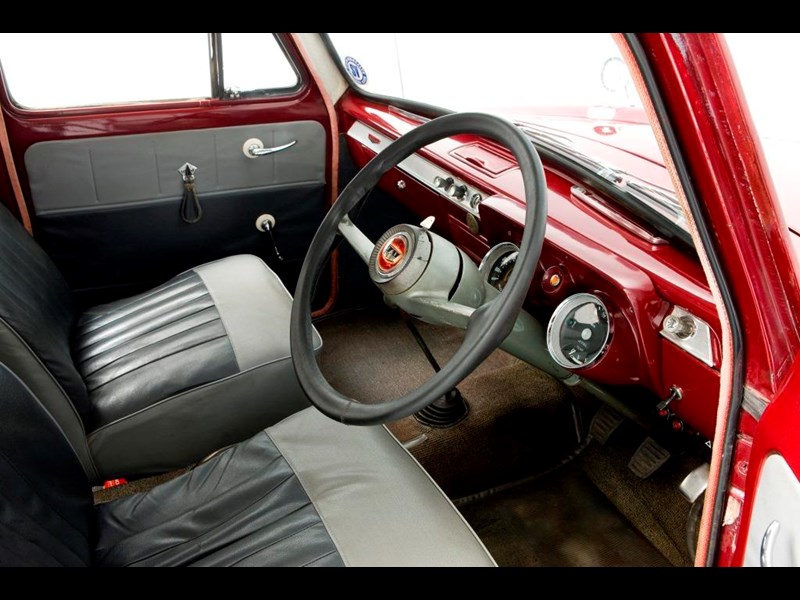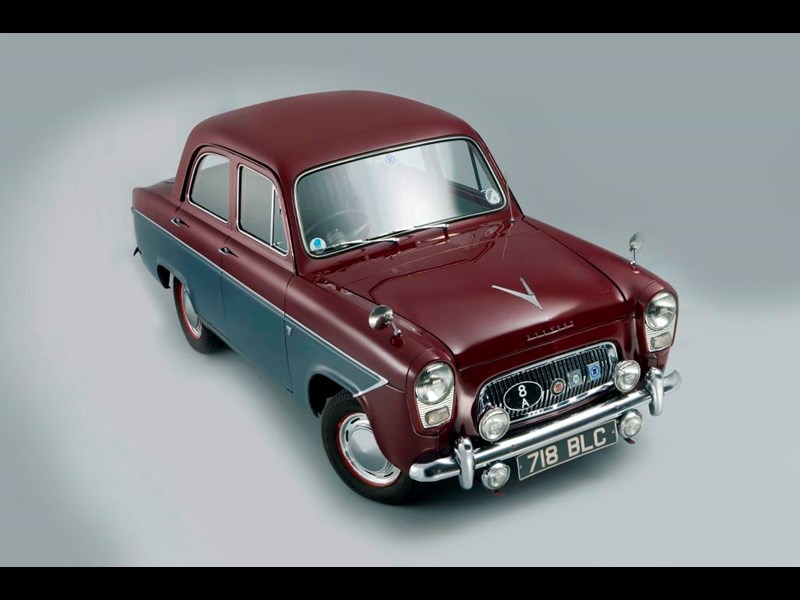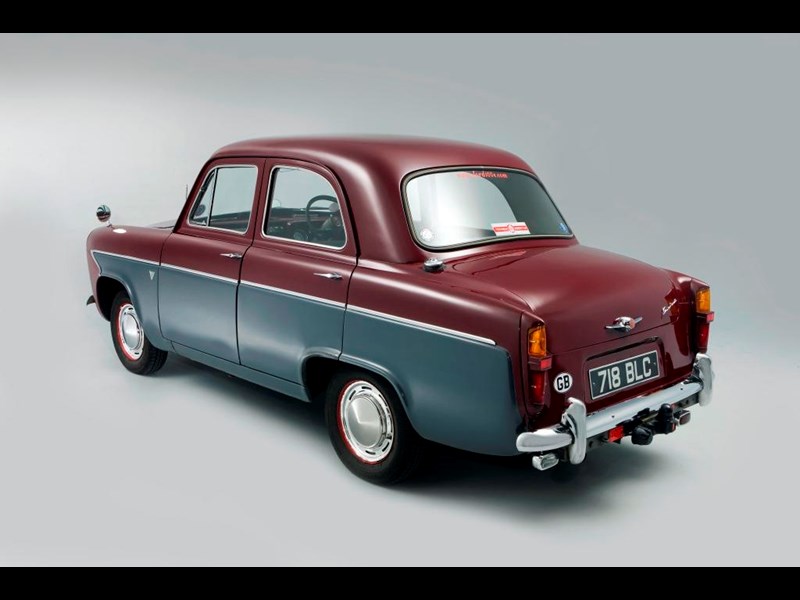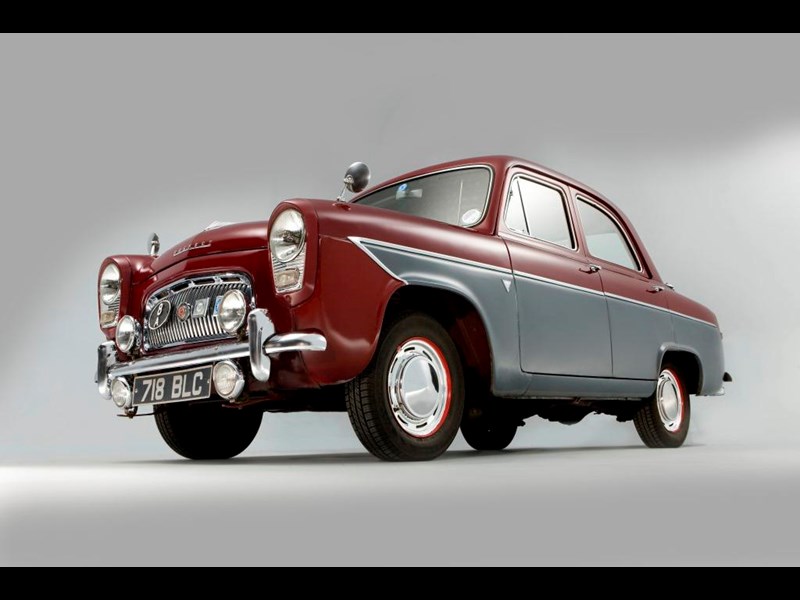Loaded with 1950s charm, these sidevalve Fords are have been attracting a new generation of followers.
Not too big, not too small with neat and achingly period styling touches and a massive dollop of 1950s character, a Ford 100E ticks all the right classic boxes. We’re talking here about sidevalve-engined Populars, Anglias and Prefects rather the similar looking 107E, which had the 105E's overhead valve Kent engine.
The 100E Anglia and Prefect looked ultra modern when they were launched in 1953 as the ‘little brothers’ to the larger, and hugely successful, overhead valve-engined Consul, Zephyr and Zodiac.
The new small Fords were cutting edge in their day, featuring unitary construction with hydraulic brakes and MacPherson strut suspension at the front. Such revolutionary technologies were, however markedly contrasted by one major aspect of the car which even today tends to make people buy other classics. Under the bonnet is the sidevalve 1172cc, developing 30bhp. This stunts real world performance somewhat.
There's no criticism about choice: Anglia and Prefects were distinguished by individual radiator treatments and dashboards. Delux versions, with extra trim followed in 1955.
Escort and Squire estate versions of the car being introduced in 1956 being based on the 5cwt van.
In 1959 the Anglia and Prefect 100E ceased production. However, these cars had been like a couple of Citroen DS variants compared to the other small Ford sold alongside them. The 103E Popular, oft known as the ‘sit up and beg Pop’ looked like and indeed almost was a prewar model, and the cheapest car on the market,
In 1959 this was replaced by a (stretching the word to its absolute limit) new Ford 100E Popular, basically the same as the previous Anglia and Prefect and once again starring that sidevalve, which lasted until 1962 as Ford's cheapest car.
VITAL STATISTICS
ENGINE 1173cc 4-cyl sidevalve
POWER 30bhp@4500rpm
TORQUE 52lb@4000rpm (104bhp@30
2500rpm)
TOP SPEED 70mph
0-60 MPH 33.8sec
FUEL CONSUMPTION 30mpg
TRANSMISSION RWD 3-speed manual
WHAT TO LOOK FOR
Body beautiful
These cars were well-built but could be given for signs of rot after 50 years. Look carefully at the MacPherson strut mountings and the inner wings to which these are attached.
Check also the door bottoms sills, especially where they meet the wings, the lower wing edges and the section where they meet the front valance, the floors, boot, spare wheel well and rear spring hangers. Also watch out for rust arounf the jacking points and around the rear valance. These cars do rot ‘honestly,; ie you can see most of the damage.
Not all is lost
Considering these cars’ relative rarity, a surprising number of body panels are available, Ex-Pressed Steel Panels will even make you a new wing, though you’ll pay £640 for it. Plus VAT. Pop Parts Plus can sell you a rear quarter panel for £35 and sills for £30, inc VAT. Specialists and club members can fix you up with secondhand panels.
Engine warnings
It is rather a charming little unit but don’t expect it to cover vast mileages without work. A thrashed sidevalve on which no-one had changed the oil (recommended frequency every 3000 miles) will be crying out for a rebuild at 25,000 miles or less. The cars were fitted with not over durable white metal bearings, so even a well maintained engine is going to need work by 40,000 miles. Most enthusiasts recommend you should fit shell-type bearings. Pop Parts have these at £350. They’ll also send you a secondhand engine for around £450 or a reconditioned one for £3000.
Obviously do listen extremely carefully for any sign of bearing rattle when checking a new purchase. The engine breather pope can become blocked, explaining an extremely lethargic unit and even oil leaks.
Changing ratios
The three-speed gearboxes have reverse where you’d expect to find first, which has caught out the odd new driver. Synchromesh often wears, and you might also find the car jumping out of gear, particularly second. Specialists will supply components or a reconditioned box, but again this is expenditure you could do without, so give a potential purchase a good checking over.
A few cars were fitted with Newtondrive clutchless transmissiom but these are just about extinct,
Talk steering
Expect some sloppiness in the steering, which could be suffering from a lack of greasing. The steering box may be worn or may need the fluid topping up or replacing, which should be done every thousand miles or so.
Stiff steering could be down to an over adjusted box or the ball races on the MacPherson struts seizing up.
FSOC for these
These cars have excellent support from the Ford Sidevalve Owners Club which prides itself on a friendly welcome and extensive spares scheme.
Extensive brake, suspension, transmissioin and electrical parts are among the vast range on offer. Club members will also help you source anything you need for your car.
Puttingthe brakes on
The handbrake linkage can seize if not regularly greased. Spares are easy to get for the all-drum system. Original spec brake pipes can corrode, especially where they go over the rear axle.
Keeping it in trim
You may be relying on autojumbles and club members for second, though Aldridge Trimming will do you a set of front seat covers for £269.64 and rears for £224.71 including VAT. Door panels are also available from Aldridge.
OUR VERDICT
Speaking as a massive fan of these cars since childhood, I can confirm there is something special about them, small and not terribly fast but packed with automotive X-factor. They are undeniably neatly styled bristling with charm and period styling details, bringing to mind a deeply scaled down Zephyr or Zodiac and goodness knows what from America. They are surprisingly well built, with thick metal. They are also extremely simple cars to work on. Any car with only one fuse is alright by us amateur mechanics! The interiors are deeply charming too, and there’s a surprising amount of space inside.
Though the sidevalve engine is slow the three-speed gearbox does make the most of the available er, power, meaning the cars are ok in town.
Admittedly something like an Austin A35 is a rocket missile by comparison but a 100E is something special. Just enjoy these unique cars for what they are, and don’t forget that half a million were made! As Peter Clarke at Small Ford Spares comments ‘They’re a good all round 1950s classic!’




